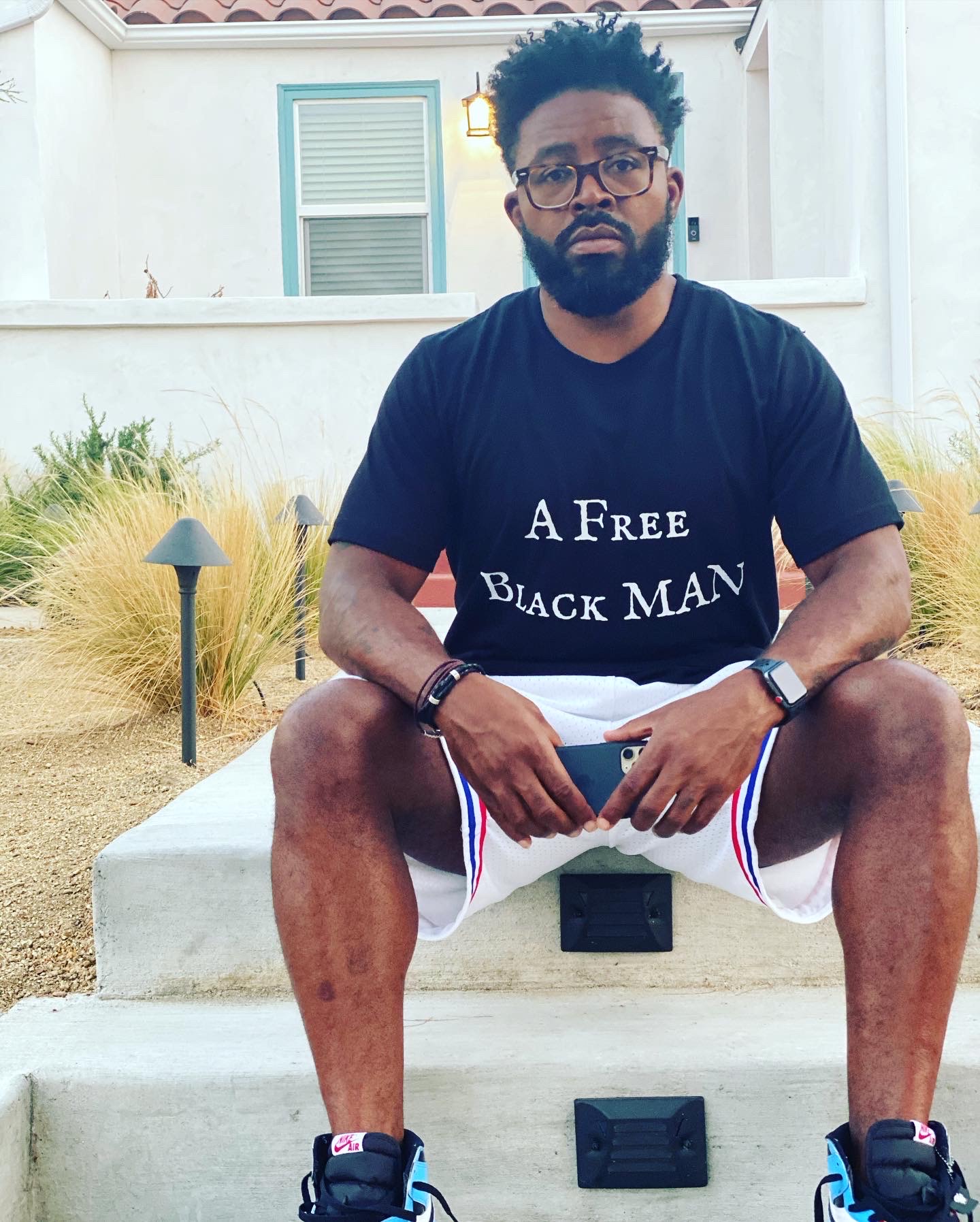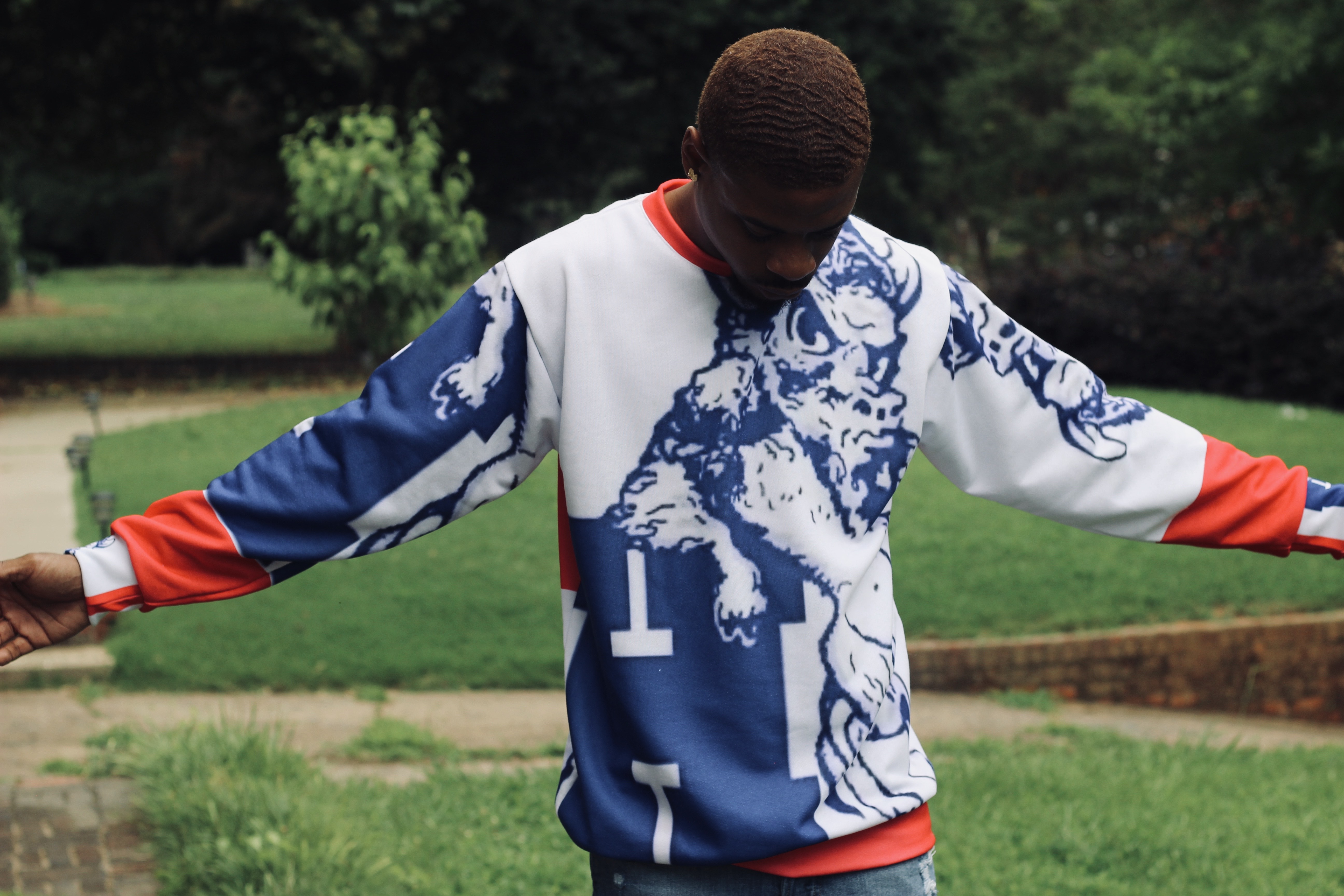“It’s more than a garment of clothing, they start conversations. Art is supposed to make people feel and make them react. I was able to translate that through graphic designs and images and these iconic black figures who I feel are gold in their own right.”
When Brandon Jones started his own streetwear label, Black is Gold, it was less about a desire to jump headfirst into a cruel industry that chews up and spits out young designers and more about making the clothes he wanted to see in the world. The Charlotte, North Carolina-based artist’s first designs were printed versions of his paintings. Eventually, the line became a way for Jones to pay tribute to his alma mater, Howard University.
“When I was in college, I actually couldn’t even afford a lot of the things that were sold in the bookstore,” Jones says, about his choice to use the renowned HBCU’s iconography. “I wanted to create clothing that could be representative of this new push to shine a light on HBCUs, and give people something positive to wear and cool and fashionable and not your typical collegiate wear.”
Black is Gold quickly attracted an audience of like-minded grads who wanted to rep their school in a way that synced with the vibrant styles of modern streetwear. Around the time the pandemic hit, Jones started to build an audience outside of college kids and recent alumni. With growing civil unrest over the killing of George Floyd by police, he pivoted once again — focusing not just on HBCUs, but Black lives and Black leaders.
We linked up with Jones to talk about his design process, the retro looks that inspired Black is Gold, and the power e-commerce has given small streetwear brands amid a global pandemic.

Tell me a little bit about Black is Gold and the design ethos and the driving force behind the label?
Overall, I’m an artist. I started off as a painter and graphic designer, creating the designs that way initially. I started finding that I might create a painting that I might not necessarily want to sell, or maybe I think it’s not getting its worth, so I started creating prints, and that lead to clothing. I started putting my art on clothing — simple things like t-shirts and hoodies at first — and the more I got into it the more it blossomed and I embraced it as a full-on clothing line.
I partnered up with other artists who maybe weren’t distributing their art that way and giving them a platform to put their art out as well, and then branching out to colleges, specifically HBCUs.
Where did the label start?
It started in Charlotte, North Carolina. That’s where I’m based. And I go back and forth between here and Oakland, and now LA to expand the brand a little bit more. I just did a product shoot out in LA recently, I’m just trying to get it to coast to coast to get different people wearing different things.
What about that varsity look appeals to you, how are you changing it and updating it for a more modern perspective?
I’m actually an HBCU graduate. I went to Howard, and when I was in college I actually couldn’t even afford a lot of the things that were sold in the bookstore. So it started with me creating things for myself that I wanted to wear, I’d print them myself, create a new design, and go out and about and I’d get a lot of attention and a lot of people asking, “Where did you get that from? Can I get one too?” So I thought, well I might as well go full throttle!
I started with my own college, I already had that base built to test it out and a network there, and I do other HBCUs as well that I’ve been incorporating slowly, but my base has been so strong that I haven’t even had the time to get to other schools and then, of course, you have to deal with licensing issues.
You have to be creative as far as what you use and how you brand it.
Can you take me through the typical design process?
The line originally started as a vintage look. I couldn’t really source out actual vintage things, but I thought, “maybe I can design things that have that look that I don’t see for sale anymore.” It started with me searching archive yearbooks, old photos, getting inspiration from things that people use to wear that maybe got discontinued or can no longer be found in mass production, and trying to recreate or remix that style and that energy because I felt like a lot of people were leaning back towards that and wanted more of a vintage or retro look.
But there wasn’t really anyone creating that, the schools have a lot of lockdowns as far as licensing, and if you do go that route you have certain limits on what you can design because now you’re licensed through the school so you have to represent them in a way they consider tasteful.
But if you know how to create your designs to where they still come off as original but also identifiable for the people who went to that school, you can color outside the lines a little bit more.

You’re fairly new to the world of fashion, but how does sustainability factor into an emerging line?
A lot of the print providers I’ve worked with are now offering eco-friendly cotton material, recycled material, so I’ve been slowly recently swapping them out when they become available for certain styles. As far as getting inventory and finding things mass-produced, it’s not that heavy on the recycled or eco-friendly yet, but every time a new option is available I switch it up.
You guys are doing a lot of masks, how are those doing sale wise and do you plan on making masks even after this year is over?
The masks really changed everything, to be honest. The masks were instant direct traffic… I already knew it would extend past medical and into fashion. I taught a year out in South Korea. Their pollution issues make it so they still rock the masks even when they have clear air. I foresaw it and was on it early and that boom — before it was mandatory; before it was a political statement. I put them out because I knew this was going to become implemented in fashion. When the masks took off I probably made $20,000 in masks alone. I’m not saying that number as a brag, that’s just to show much of a spike it was, that need and necessity.
7 billion people in the world. If you have this product, you should be able to sell it.
Knowing human nature and individuality, people aren’t going to want to wear the same thing. NFL masks, NBA masks, I got in on it early. The beautiful thing about it was that it generated traffic to other things I had been selling. Things that have been sitting on my site for months now are selling consistently because the masks have brought so many new customers. Now, as they are getting their masks, they’re checking out prints, shirts, pants… A $20 mask order turns into a $300 order and a new customer.
Can you speak on the way that history plays a part in Black is Gold. I’m thinking specifically about the way it was inspired by retro looks, a lot of the designs bring in Black icons like Langston Hughes and Harriet Tubman.
When you hear “gold” you hear the gold standard. You think of excellence, opulence, wealth — this is to curtail stereotypes. The clothing is meant to exemplify people who represented that in the past. Something to let people embody themselves, and the happiness of wearing themselves. Support different independent businesses instead of wearing designers and companies that don’t really do anything for your community or for your kind of self-expression or self-worth.
You can wear things that are representational but can teach at the same time. It’s more than a garment of clothing, they start conversations. It’s not just a brand about black people or blackness, but a certain specific experience — the gold standard.
Because of the pandemic, industries worldwide are changing. In this opportunity how do you hope to see the fashion world change?
I don’t know because I still don’t consider myself in the fashion world yet. But it’s hard to tell, because it’s all contingent on if we’re going to be out socially a lot more and extroverted. Fashion is heavily contingent on showing somebody. Luckily, with social media, we can still be home and post our fits, and things are circulating but I don’t know how long that’s going to last. Maybe people won’t buy new clothes come January. But if things get back to normal, whatever normal is, it’s only going to boom.
One thing it’s doing is making people more comfortable with e-commerce and buying clothes online.
That probably levels the playing field for smaller designers to compete with the larger labels…
People are definitely wanting things that are different. They want to post pictures wearing something that nobody is wearing. As a designer, you have to be contingent upon that.

